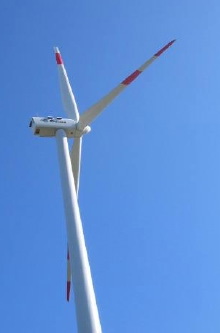| Wind Watch is a registered educational charity, founded in 2005. |
10-meter section of blade broke off and flew 200 meters
Translate: FROM English | TO English
Translate: FROM English | TO English
Witnesses are not sure whether the incident was caused by lightning or not.
Last year the cabin was struck by lightning and that damage (according to witnesses) was repaired.
The turbine was in operation for only a short time, then stopped. It has not operated since. Officially, it’s the one with the number A1, nearest the castle [Montepò, Scansano, Tuscany, Italy].
Then there was a high wind at the beginning of February 2008, and the next day they noticed that a 10-m piece of one of the rotor blades was missing. This piece was recovered 200m away in a field by the Endesa staff.
Walter da Murci got this information last Saturday (1st March 2008 – the turbine in question is not visible from his house) and set out on Sunday (2nd March 2008) to take photos, one of which is presented below. He is now trying to make this incident as public as possible.

Since that day of high wind in February only 5 windmills have been in operation – the others are stationary.
According to his notes for February, da Murci observed from his house that in the following days (e.g., 14th and 18th February, among others) workers examined the blades of two of the turbines with the help of a crane. These two turbines are now stationary.
From the point of view of the witnesses, the incident is important because the turbines that are still in operation are the ones only a few yards from the road and from one lady’s house, which is just 130m away. The people living in the area have to use this road, but they are now afraid to do so.
Gail Mara, now residing in Meran, Italy, because of health problems caused by the turbines in Scansano, provided National Wind Watch with the translation for this article from a report by Walter da Murci to the Italia Nostra committee.
This article is the work of the source indicated. Any opinions expressed in it are not necessarily those of National Wind Watch.
The copyright of this article resides with the author or publisher indicated. As part of its noncommercial educational effort to present the environmental, social, scientific, and economic issues of large-scale wind power development to a global audience seeking such information, National Wind Watch endeavors to observe “fair use” as provided for in section 107 of U.S. Copyright Law and similar “fair dealing” provisions of the copyright laws of other nations. Send requests to excerpt, general inquiries, and comments via e-mail.
| Wind Watch relies entirely on User Funding |
 (via Stripe) |
 (via Paypal) |
Share:

